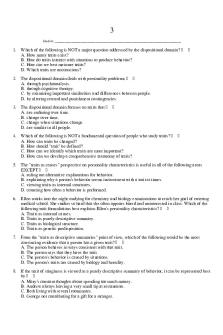PSY-102 General Psychology Brain Project-2 PDF

| Title | PSY-102 General Psychology Brain Project-2 |
|---|---|
| Author | Mia Goltiao |
| Course | Educational Psychology |
| Institution | Chemeketa Community College |
| Pages | 3 |
| File Size | 158.3 KB |
| File Type | |
| Total Downloads | 97 |
| Total Views | 140 |
Summary
Psychology ...
Description
PSY-102 General Psychology Topic 1 – Introduction to Psychology and Role of Biology Mini Brain Project
Part 1: Using your research thoroughly answer the questions below: 1. Where is the area or structure located? According to “The Brain Book” (2009), the temporal lobe is located within the middle section of the brain. When broken up into hemispheres, it is located on both the right and the left side of the brain specifically under the Sylvian fissure. The Sylvian fissure is a large sulcus separating the temporal lobe from the frontal lobe and parietal lobes. The temporal lobe is also found to be slightly longer on the left side of the hemisphere.
2. What are its major functions? The major functions of the temporal lobe include hearing, language, and memory. Though the temporal lobe is important for memory, it is less important for implicit memories such as “classical conditioning and procedural memory” (“Psychology in Your Life”, 2019). The temporal lobes also have connections with our neurons and are responsible for strengthening those connections whenever we learn something. Additionally, the temporal lobes help us with facial recognition and any detailed visuals.
3. What techniques are used to view or measure it? A brain imaging technique called the EEG can be used to view the temporal lobe. It stands for electroencephalograph which measures the electronic activity caused by the brain. Electrodes are placed on the scalp which then result in electrical signals from neurons located in the brain. It is said to be one of the few techniques around that is able to pick up high levels of temporal activity (Demitri, M. , 2020).
4. What happens when it is damaged?
Since the temporal lobe is in control of so many important factors in life, there is a lot that can go wrong if damaged. Looking at memory, you might fail to recognize a persons face or recall their name. Memories can be very vivid and are an important part for the brain to remember. If damage occurs, it can cause the brain to falsely alter a memory and create something that has never actually happened (“The Brain Book”, 2009). The temporal lobe is also in charge of speech and language. This means that any severe damage caused to this area of the brain could cause serious altercations to one’s speech. Overall, the temporal lobe is vital to the human brain, if any damage occurs, it will cause a major disruption to all memory and speech.
5. What other structures is it near? The the temporal lobe is located near the frontal lobe. The frontal lobe is responsible for a lot of memory like the temporal lobe is as well. As stated before, the temporal lobe is located under the Sylvian fissure (“The Human Brain”, 2009). This structure separates the temporal lobe from the frontal lobe and runs down laterally. The temporal lobe is where general knowledge is stored, so it is very important that these two structures surround this lobe.
6. What other structures help or perform similar functions? The frontal lobe is most likely the most similar to the temporal lobe given the functions they both are responsible for. Just like the temporal lobe, the frontal lobe takes care of many actions dealing with speech. The frontal lobe controls functions such as sensory and motor skills as well (“The Brain”, n.d.). The temporal lobe is in control of speech and language, so both lobes are similar with dealing in that area. Though both lobes have specific functions, they are similar when looking at the general controls of speech.
References: Carter, R. (2009). The Brain Book . Retrieved from https://search-credoreference-com.lopes.idm.oclc.org/content/title/dkbrain? tab=entry_view&entry_id=10239025 Grison, S. & Gazzaniga, M. (2019). Psychology in Your Life. Retrieved from https://digital.wwnorton.com/59227/r/goto/cfi/8!/4 The Brain. (n.d.) Retrieved from
https://lc.gcumedia.com/zwebassets/courseMaterialPages/psy102_theBrain.php
Demitri, M. (2020). Types of Brain Imaging Techniques. Retrieved from https://psychcentral.com/lib/types-of-brain-imaging-techniques/
Part 2: Once you have answered the questions above, please select an activity below and complete it....
Similar Free PDFs

General Psychology Summary
- 25 Pages

General Psychology Exam Review
- 13 Pages

General Psychology Notes
- 21 Pages

General psychology final exam guide
- 22 Pages

PSY102-RS-Stress Pins
- 3 Pages
Popular Institutions
- Tinajero National High School - Annex
- Politeknik Caltex Riau
- Yokohama City University
- SGT University
- University of Al-Qadisiyah
- Divine Word College of Vigan
- Techniek College Rotterdam
- Universidade de Santiago
- Universiti Teknologi MARA Cawangan Johor Kampus Pasir Gudang
- Poltekkes Kemenkes Yogyakarta
- Baguio City National High School
- Colegio san marcos
- preparatoria uno
- Centro de Bachillerato Tecnológico Industrial y de Servicios No. 107
- Dalian Maritime University
- Quang Trung Secondary School
- Colegio Tecnológico en Informática
- Corporación Regional de Educación Superior
- Grupo CEDVA
- Dar Al Uloom University
- Centro de Estudios Preuniversitarios de la Universidad Nacional de Ingeniería
- 上智大学
- Aakash International School, Nuna Majara
- San Felipe Neri Catholic School
- Kang Chiao International School - New Taipei City
- Misamis Occidental National High School
- Institución Educativa Escuela Normal Juan Ladrilleros
- Kolehiyo ng Pantukan
- Batanes State College
- Instituto Continental
- Sekolah Menengah Kejuruan Kesehatan Kaltara (Tarakan)
- Colegio de La Inmaculada Concepcion - Cebu










